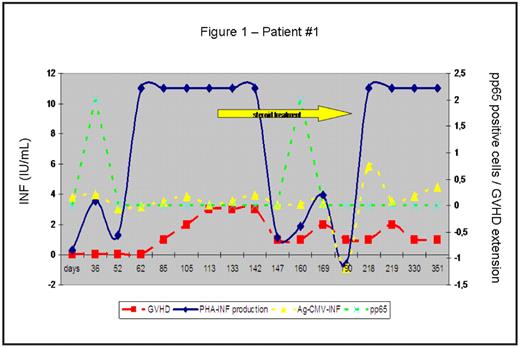Abstract
Background. GVHD is associated with a high morbidity and mortality in alloSCT patients. An early diagnosis of GVHD could reduce this adverse impact on the outcome of alloSCT. The effect of Th1 cytokine IFN-γ is crucial in the pathogenesis of GVHD and, as expected, higher protein levels are reported in the serum of patients with active chronic GVHD. The monitoring of IFN-γ basal levels as well as IFN-γ induced by mitogen stimulation in the blood samples of patients after alloSCT could help the management and the prediction of GVHD. A recent ELISA based test (QuantiFERON®-CMV) could measure specific (anti-CMV) and aspecific production of IFN-γ in whole blood. The aim of this study is to assess the reliability of the positive control of the QuantiFERON®-CMV kit as new marker for GVHD early diagnosis.
Methods. The study was performed in 2 phases. In the first phase of the study, 92 whole blood specimens were collected and analyzed from 29 patients undergoing alloSCT. In the second phase 10 patients were observed prospectively with collection of blood samples every 2–3 weeks since engraftment until 4–6 months after SCT in order to study the PHA stimulated IFN-γ production in relationship with the onset of chronic GVHD. QuantiFERON®-CMV is an in vitro diagnostic test that use an antigenic human cytomegalovirus proteins (CMV) peptide cocktail to stimulate cells from whole blood. The mitogen-stimulated (PHA) plasma sample is used as an IFN-γ positive control for each specimen tested. Detection of interferon-γ (IFN-γ) by ELISA is used to identify responses. In order to assess the association between IFN-γ response due to PHA stimulation and GVHD, the positivity of the test was determined according to 2 different cut-off: #1) 0,5 IU/mL as defined by manufacturer, #2) 9 IU/mL as experimentally defined by the median of the observations in our data set. GVHD extension was defined by Seattle criteria and/or the number of involved sites, Chi-square test was used to assess the statistical correlation between IFN-γ production and clinical outcomes.
Results. In the first phase, among 92 samples 70 were positive for the PHA stimulated IFN-γ production according to the cut-off #1; 61% (43/70) were associated with GVHD whereas 27% (6/22) with lower PHA stimulated IFN-γ production were associated with GVHD: this difference was proved to be significant (p=0.005). According to the cut-off #2 46 samples out of 92 were positive for the PHA stimulated IFN-γ production; 71% (33/46) were associated with GVHD whereas 34% (16/46) with lower PHA stimulated IFN-γ production were associated with GVHD: this difference was proved to be significant (p=0.000).
In the second prospective phase of the study, 7/10 patients became positive for the PHA stimulated IFN-γ production after alloSCT: 6 developed subsequently chronic GVHD. The median time to the onset of GVHD was 100 days from the first sample proved positive above the cut-off #1 and 33 days from the first sample proved positive above the cutoff#2. Four patients received steroid treatment for extensive chronic GVHD and their PHA stimulated IFN-γ production dropped after treatment (figure 1, continuous line).
Conclusions: The PHA stimulated IFN-γ production is associated with GVHD. The monitoring of PHA stimulated IFN-γ after alloSCT seems to predict the onset of GVHD and could help in the modulation of immunosuppressive treatment. However, larger prospective studies are needed.
Disclosures: No relevant conflicts of interest to declare.
Author notes
Corresponding author


This feature is available to Subscribers Only
Sign In or Create an Account Close Modal